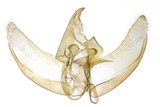Agnoea josephinae (Toll, 1956) Species
Last modified: Dec. 5, 2025, 6:48 p.m.
An uncommon species throughout Belgium. Study of the genitalia is sometimes necessary to identify the specimens, especially when they are worn.
Details
- Classification
- Family: Lypusidae > Subfamily: Lypusinae > Genus: Agnoea > Subgenus: Tubuliferodes > Species: Agnoea josephinae
- Vernacular names
- Zomerzaksikkelmot (NL)
- First mention in Belgium
- Janmoulle E. 1958b. Espèces nouvelles pour la faune belge (suite). — Lambillionea 58: 73–75. On page 74.
- Status
-
Native
Distribution
Egg
Whitish at the oviposition but turning reddish after a few days, oblong and strongly grooved longitudinally.
Caterpillar
Reddish with head capsule, thoracic and anal plates black. Later instars have a greyish body; head black, prothoracic plate reddish brown
Case
At first, a small, oval case is constructed by folding and spinning a piece of dead leaf; every subsequent case is made in the same way, each time using a larger part of a leaf.
Bionomics
The larva lives in a case made from a folded, dried leaf. The entire development takes two years and during that period 7 to 8 of such cases are constructed, each larger than the previous one. The caterpillar can turn around inside the case and move in both directions.
Pupation inside the last case is attached to a twig or at the base of a tree trunk.
Adults become active during the evening and come readily to light.
Flight periods
One generation a year from early June till early September.
Observed on
- Substrates:
- Decaying vegetable matter
Polyphagous. The caterpillar feeds on dead, withered or fresh leaves of Carpinus betulus, Fagus sylvatica, Populus, and Vaccinium myrtillus.
Habitat
Different kinds of forests with a preference for mixed forests, parks with many trees.









